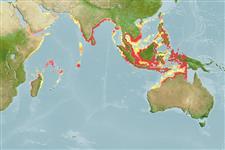>
Clupeiformes (Herrings) >
Dorosomatidae (Gizzard shads and sardinellas)
Etymology: Sardinella: Latin and Greek, sarda = sardine; name related to the island of Sardinia; diminutive (Ref. 45335).
More on author: Bleeker.
Environment: milieu / climate zone / depth range / distribution range
Ecologia
marino; distribuzione batimetrica 0 - 50 m (Ref. 188). Tropical; 25°N - 23°S, 41°E - 137°E (Ref. 188)
Indo-West Pacific: Madagascar (but apparently not elsewhere in the western Indian Ocean), Madras, Indonesia, northern Australia. Chan's Hong Kong and Taipei specimens were most likely Sardinella hualiensis. Occurrence in Thailand (Ref. 1632) needs to be confirmed.
Size / Peso / Age
Maturity: Lm ? range ? - ? cm
Max length : 13.0 cm SL maschio/sesso non determinato; (Ref. 188); common length : 12.0 cm SL maschio/sesso non determinato; (Ref. 188)
Spine dorsali (totale) : 0; Raggi dorsali molli (totale) : 13 - 21; Spine anali: 0; Raggi anali molli: 12 - 23. Body deep; total scutes 29 to 32. Vertical striae on scales overlapping or sometimes continuous at center of scale, numerous small perforations on hind part of scale. Closely resembles S. hualiensis which has dark dorsal and caudal fin tips. Differs from other deep-bodied species chiefly in its lower gill raker count and presence of a dark spot at dorsal fin of origin.
Forms schools in coastal waters (Ref. 188, 75154).
Life cycle and mating behavior
Maturità | Riproduzione | Deposizione | Uova | Fecundity | Larve
Whitehead, P.J.P., 1985. FAO Species Catalogue. Vol. 7. Clupeoid fishes of the world (suborder Clupeoidei). An annotated and illustrated catalogue of the herrings, sardines, pilchards, sprats, shads, anchovies and wolf-herrings. FAO Fish. Synop. 125(7/1):1-303. Rome: FAO. (Ref. 188)
IUCN Red List Status (Ref. 130435: Version 2024-1)
Threat to humans
Harmless
Human uses
Pesca: scarso interesse commerciale
Strumenti
Special reports
Download XML
Fonti Internet
Estimates based on models
Preferred temperature (Ref.
123201): 27.6 - 29.2, mean 28.6 °C (based on 786 cells).
Phylogenetic diversity index (Ref.
82804): PD
50 = 0.5000 [Uniqueness, from 0.5 = low to 2.0 = high].
Bayesian length-weight: a=0.00813 (0.00495 - 0.01335), b=3.09 (2.95 - 3.23), in cm total length, based on LWR estimates for this species & Genus-body shape (Ref.
93245).
Trophic level (Ref.
69278): 2.9 ±0.3 se; based on size and trophs of closest relatives
Resilienza (Ref.
120179): Alto, tempo minimo di raddoppiamento della popolazione meno di 15 mesi (Preliminary K or Fecundity.).
Fishing Vulnerability (Ref.
59153): Low vulnerability (10 of 100).
Nutrients (Ref.
124155): Calcium = 338 [184, 527] mg/100g; Iron = 2.11 [1.25, 3.75] mg/100g; Protein = 20.4 [19.5, 21.4] %; Omega3 = 0.312 [0.152, 0.614] g/100g; Selenium = 82.9 [43.0, 161.6] μg/100g; VitaminA = 36.7 [11.6, 111.0] μg/100g; Zinc = 1.4 [1.0, 1.9] mg/100g (wet weight);
